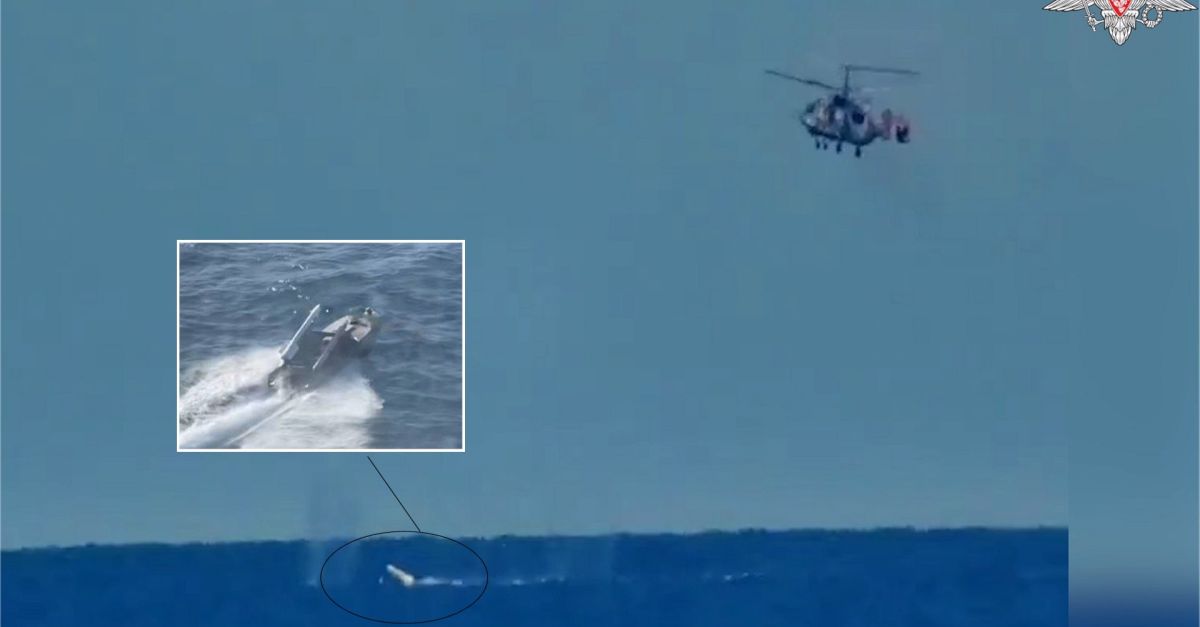Breaking news
Breaking News Ukraine deploys new naval drone armed with missiles against Russia.
According to information published by AIF on May 6, 2024, the Armed Forces of Ukraine have begun equipping their naval drones with air defense missiles like the R-60 and R-73. This information is based on video footage released by the Russian Ministry of Defense.
Follow Army Recognition on Google News at this link

New Ukrainian drone armed with air defense missiles pursued by a Russian helicopter. (Picture source: Russian MoD)
The footage depicts a Russian Armed Forces helicopter pursuing a Ukrainian unmanned boat. The naval drone was equipped with two air-to-air missiles guided by thermal targeting. However, this new tactic was not successful, as the drone failed to hit the Russian helicopter.
The missile was launched but missed its target. Russian forces managed to immobilize the Ukrainian naval drone and subsequently destroy it during the operation.
Air Defense missiles
The R-60 and R-73 missiles are well-known Soviet and Russian air-to-air weapons. The R-60, designated as AA-8 "Aphid" by NATO, is a short-range infrared-guided missile optimized for dogfighting and hitting agile targets at ranges of up to 8 kilometers. It uses an infrared homing system and has been integrated with various Soviet aircraft, such as the MiG-21 and MiG-29.
The R-73, known as the AA-11 "Archer" in NATO, is a more advanced short-range missile. It incorporates an autopilot system and sophisticated sensors for better agility and accuracy. Its seeker is cooled to enhance sensitivity, allowing it to detect targets at wider angles.
This gives the missile better maneuverability and a larger engagement envelope compared to the R-60. With various enhancements over its predecessors, it can accurately lock onto fast and maneuverable aircraft, even when launched from extreme off-boresight angles.
Future of the Naval Warfare
Naval drones armed with missiles could redefine the future of maritime conflict, offering unmatched strategic advantages. Their ability to operate independently in high-risk areas while maintaining long-range precision strikes would provide a cost-effective force multiplier. This innovation could drastically reduce the need for manned ships in dangerous areas, protecting personnel while delivering effective defense and offense.
Their potential to patrol strategically significant chokepoints or secure vast territorial waters would also reshape traditional concepts of naval dominance.
Drones would need to differentiate between military targets and civilian vessels accurately, autonomously identifying and neutralizing threats. Secure, encrypted communications would be vital to ensure seamless integration with manned fleets, allowing real-time information sharing and coordinated strikes.
The introduction of such drones would require a rethinking of naval doctrine. The ability to disrupt enemy fleets, conduct reconnaissance, and target vessels autonomously would shift the focus from traditional defensive strategies toward proactive, asymmetric engagements. This shift could alter the global naval balance, with smaller nations gaining the potential to defend their maritime interests against larger fleets effectively.


























